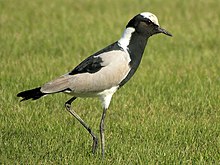Lapwing
| Lapwings | |
|---|---|

| |
| Blacksmith lapwing(Vanellus armatus) | |
| Scientific classification | |
| Domain: | Eukaryota |
| Kingdom: | Animalia |
| Phylum: | Chordata |
| Class: | Aves |
| Order: | Charadriiformes |
| Family: | Charadriidae |
| Subfamily: | Vanellinae Bonaparte,1842 |
| Genera | |
|
Erythrogonys | |
Lapwings(subfamilyVanellinae) are any of various ground-nesting birds (familyCharadriidae) akin toploversanddotterels.They range from 10 to 16 inches (25 to 41 cm) in length, and are noted for their slow, irregular wingbeats in flight and a shrill, wailing cry.
The traditional terms "plover", "lapwing", and "dotterel" do not correspond exactly to current taxonomic models; thus, several of the Vanellinae are often called plovers, andonea dotterel, while a few of the "true" plovers (subfamilyCharadriinae) are known colloquially as lapwings. In general, a lapwing can be thought of as a larger plover.
In Europe's Anglophone countries,lapwingrefers specifically to thenorthern lapwing,the only member of this group to occur in most of the continent and thus the first bird to go by the English namelapwing(also known aspeewitorpyewipe).
In the fanciful taxonomy promoted by medievalcourtesy books,a group of lapwings was called a "deceit".[1]
Systematics[edit]
While authorities generally agree that there are approximately 25 species of Vanellinae, classifications within the subfamily remain confused. Some workers[who?]have gone so far as to group all the "true" lapwings (except thered-kneed dotterel) into the single genusVanellus.Current consensus favors a more moderate position, but it is unclear which genera to split. TheHandbook of Birds of the Worldprovisionally places all Vanellinae inVanellusexcept the red-kneed dotterel, which is in themonotypicErythrogonys.Itsplesiomorphichabitusresembles that ofplovers,but details like the missinghallux(hind toe) are like those of lapwings: it is still not entirely clear whether it is better considered the mostbasalplover or lapwing.[2]TheIOCalso recognizes a monotypic genusHoploxypterusfor thepied plover.
Many coloration details of the red-kneed dotterel also occur here and there among the living members of the main lapwingclade.Its position as the mostbasalof the living Vanellinae or just immediately outside it thus means that theirlast common ancestor– or even the last common ancestor of plovers and lapwings – almost certainly was a plover-sized bird with a black crown and breast-band, a white feather patch at the wrist, no hallux, and alipochromic(probably red) bill with a black tip. Its legs were most likely black or the color of the bill's base.[3]
Evolution[edit]
Thefossilrecord of the Vanellinae is scant and mostly recent in origin; noNeogenelapwings seem to be known. On the other hand, it appears as if early in theirevolutionaryhistory the plovers, lapwings and dotterels must have been almost one and the same, and they are hard to distinguishosteologicallyeven today. Thus, since the Red-kneed Dotterel is so distinct that it might arguably be considered amonotypicsubfamily, reliably dating its divergence from a selection of true lapwings and plovers would also give a good idea ofcharadriid waderevolution altogether.
A mid-Oligocene– c.28 mya (million years ago) – fossil fromRupelmondeinBelgiumhas been assigned toVanellus,but even if the genus were broadly defined, it is entirely unclear if the placement is correct. Its age ties in with the appearance of the first seemingly distinct Charadriinae at about the same time, and with the presence of morebasalCharadriidae a few million years earlier. However, the assignment of fragmentary fossils to Charadriinae or Vanellinae is not easy. Thus, it is very likely that the charadriid waders originate around theEocene-Oligocene boundary – roughly 40–30 mya – but nothing more can be said at present. If the Belgian fossil is not a true lapwing, there are actually no Vanellinae fossils known before theQuaternary.[4]
TheEarly OligocenefossilDolicopterus[5]fromRonzon, Francemay be such an ancestral member of the Charadriidae or even the Vanellinae, but it has not been studied in recent decades and is in dire need of review.[6]
Apart from theprehistoricVanellus,theextinctlapwing genusViatorhas been described from fossils. Its remains were found in thetar pitsofTalarainPeruand it lived in theLate Pleistocene.Little is known of this rather large lapwing; it may actually belong inVanellus.[7]
The remainingCharadriiare highset and/or chunky birds, even decidedly larger than a lot of thescolopacid waders.The evolutionary trend regarding the Charadriidae – which make up most of the diversity of the Charadrii – thus runs contrary toCope's Rule.[3]
List of species in taxonomic order[edit]
GenusVanellus
- Northern lapwing,Vanellus vanellus
- White-headed lapwing,Vanellus albiceps
- Southern lapwing,Vanellus chilensis
- Grey-headed lapwing,Vanellus cinereus
- Crowned lapwing,Vanellus coronatus
- Long-toed lapwing,Vanellus crassirostris
- River lapwingor spur-winged lapwing,Vanellus duvaucelii
- Red-wattled lapwing,Vanellus indicus
- Masked lapwing,Vanellus miles
- Spur-winged lapwingor spur-winged plover,Vanellus spinosus
- Banded lapwing,Vanellus tricolor
- Blacksmith lapwing,Vanellus armatus
- Black-headed lapwing,Vanellus tectus
- Yellow-wattled lapwing,Vanellus malabaricus
- Senegal lapwing,Vanellus lugubris
- Black-winged lapwing,Vanellus melanopterus
- African wattled lapwing,Vanellus senegallus
- Spot-breasted lapwing,Vanellus melanocephalus
- Brown-chested lapwing,Vanellus superciliosus
- Javanese wattled lapwing,Vanellus macropterus
- Sociable lapwing,Vanellus gregarius
- White-tailed lapwing,Vanellus leucurus
- Andean lapwing,Vanellus resplendens
GenusHoploxypterus
- Pied lapwing,Hoploxypterus cayanus
GenusErythrogonys
- Red-kneed dotterel,Erythrogonys cinctus
Footnotes[edit]
- ^Lipton, James (1991).An Exaltation of Larks.Viking.ISBN978-0-670-30044-0.
- ^Piersma & Wiersma (1996), Thomaset al.(2004)
- ^abPiersma & Wiersma (1996)
- ^Piersma & Wiersma (1996), Mlíkovský (2002)
- ^NotDolichopterus,contraMlíkovský (2002)
- ^Mlíkovský (2002)
- ^Campbell (2002)
References[edit]
- Campbell, Kenneth E. Jr. (2002). A new species of Late Pleistocene lapwing from Rancho La Brea, California [English with Spanish abstract].Condor104:170–174.DOI:10.1650/0010-5422(2002)104[0170:ANSOLP]2.0.CO;2HTML abstract and first page image
- Mlíkovský, Jirí (2002).Cenozoic Birds of the World, Part 1: Europe.Ninox Press, Prague.ISBN80-901105-3-8PDF fulltext
- Piersma, Theunis & Wiersma, Popko (1996). Family Charadriidae (Plovers).In:del Hoyo, Josep; Elliott, Andrew & Sargatal, Jordi (eds.):Handbook of Birds of the World(Volume 3: Hoatzin to Auks): 384–443, plates 35–39. Lynx Edicions, Barcelona.ISBN84-87334-20-2
- Thomas, Gavin H.; Wills, Matthew A. & Székely, Tamás (2004). A supertree approach to shorebird phylogeny.BMC Evol. Biol.4:28.doi:10.1186/1471-2148-4-28PMID15329156PDF fulltextSupplementary Material

